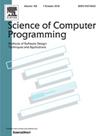System-level simulation-based verification of Autonomous Driving Systems with the VIVAS framework and CARLA simulator
IF 1.4
4区 计算机科学
Q3 COMPUTER SCIENCE, SOFTWARE ENGINEERING
引用次数: 0
Abstract
Ensuring the safety and reliability of increasingly complex Autonomous Driving Systems (ADS) poses significant challenges, particularly when these systems rely on AI components for perception and control. In the ESA-funded project VIVAS, we developed a comprehensive framework for system-level, simulation-based Verification and Validation (V&V) of autonomous systems. This framework integrates a simulation model of the system, an abstract model describing system behavior symbolically, and formal methods for scenario generation and verification of simulation executions. The automated scenario generation process is guided by diverse coverage criteria.
In this paper, we present the application of the VIVAS framework to ADS by integrating it with CARLA, a widely-used driving simulator, and its ScenarioRunner tool. This integration facilitates the creation of diverse and complex driving scenarios to validate different state-of-the-art AI-based ADS agents shared by the CARLA community through its Autonomous Driving Challenge. We detail the development of a symbolic ADS model and the formulation of a coverage criterion focused on the behaviors of vehicles surrounding the ADS. Using the VIVAS framework, we generate and execute various highway-driving scenarios, evaluating the capabilities of the AI components. The results demonstrate the effectiveness of VIVAS in automating scenario generation for different off-the-shelf AI solutions.
基于VIVAS框架和CARLA模拟器的自动驾驶系统系统级仿真验证
确保日益复杂的自动驾驶系统(ADS)的安全性和可靠性带来了重大挑战,特别是当这些系统依赖人工智能组件进行感知和控制时。在esa资助的项目VIVAS中,我们开发了一个全面的框架,用于系统级,基于仿真的自主系统验证和验证(V&;V)。该框架集成了系统的仿真模型、象征性地描述系统行为的抽象模型,以及用于场景生成和仿真执行验证的形式化方法。自动化的场景生成过程由不同的覆盖标准指导。在本文中,我们通过将VIVAS框架与广泛使用的驾驶模拟器CARLA及其场景运行器工具集成在一起,介绍了VIVAS框架在ADS中的应用。这种集成有助于创建多样化和复杂的驾驶场景,以验证CARLA社区通过其自动驾驶挑战赛共享的不同最先进的基于人工智能的ADS代理。我们详细介绍了象征性ADS模型的开发和针对ADS周围车辆行为的覆盖标准的制定。使用VIVAS框架,我们生成并执行了各种公路驾驶场景,评估了人工智能组件的能力。结果证明了VIVAS在为不同的现成AI解决方案自动化场景生成方面的有效性。
本文章由计算机程序翻译,如有差异,请以英文原文为准。
求助全文
约1分钟内获得全文
求助全文
来源期刊

Science of Computer Programming
工程技术-计算机:软件工程
CiteScore
3.80
自引率
0.00%
发文量
76
审稿时长
67 days
期刊介绍:
Science of Computer Programming is dedicated to the distribution of research results in the areas of software systems development, use and maintenance, including the software aspects of hardware design.
The journal has a wide scope ranging from the many facets of methodological foundations to the details of technical issues andthe aspects of industrial practice.
The subjects of interest to SCP cover the entire spectrum of methods for the entire life cycle of software systems, including
• Requirements, specification, design, validation, verification, coding, testing, maintenance, metrics and renovation of software;
• Design, implementation and evaluation of programming languages;
• Programming environments, development tools, visualisation and animation;
• Management of the development process;
• Human factors in software, software for social interaction, software for social computing;
• Cyber physical systems, and software for the interaction between the physical and the machine;
• Software aspects of infrastructure services, system administration, and network management.
 求助内容:
求助内容: 应助结果提醒方式:
应助结果提醒方式:


